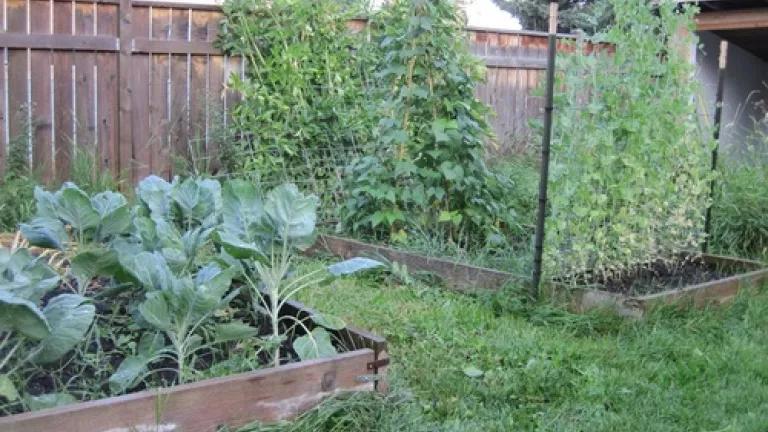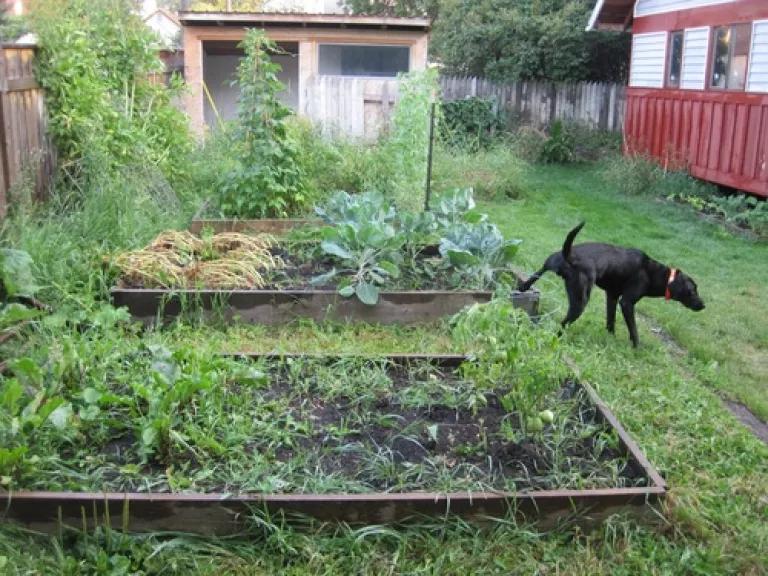
Brussels sprouts, sugar snap peas on a homemade hog panel trellis, and pole beans on a homemade bamboo trellis in my backyard.
I’m halfway through the book Tomatoland by Barry Estabrook, and my appetite for tomatoes is gasping for air on its deathbed. I find myself shooting dirty looks at bottles of Heinz ketchup at the grocery store, and I've been flipping the bird at the bowls of Paul Newman's Chunky Mild Salsa I encounter at summer barbecues. The reality, of course, is that my discontent is misplaced, as the tomatoes are the victims here.
(And, for the record, I love Paul Newman. He played Reggie Dunlop in Slap Shot, which is arguably the greatest film of the twentieth century. The guy's a hero to generations of hockey players, myself included.)
In Tomatoland, Estabrook tells a harrowing story about pesticides, fungicides, environmental abuse, and human slavery – also known as the Florida tomato industry. Ever wonder how you’re able to buy a perfectly round, red tomato in the middle of winter at your local grocery store? That tomato was likely grown in Florida, where it was slathered with all sorts of chemicals, picked when it was hard and green under horrendous working conditions, then gassed with methyl bromide to turn it red, and finally trucked to a produce aisle near you. Oh, and one more thing: that tomato tastes like shit.
And tomatoes are just one example. What about other fruits and vegetables? Or the disgusting misery of our industrial beef, poultry, and pork industries? Our modern food and agriculture system has spun wildly out of control, as writers like Estabrook, Michael Pollan (The Omnivore’s Dilemma), Mark Bittman (The New York Times), and others have vividly illustrated. The good news, however, is that we can fight back and reclaim some sanity in how we acquire and consume our food.
Small, locally owned farms continue to pop up all over the country, and summer farmers’ markets have become a regular staple in many communities. Some towns even have winter farmers’ markets now, and the New York Times just ran a story about there possibly being too many farmers’ markets in parts of the country these days. Alternatively, you could buy fruits, veggies, and other goodies directly from the farmer through a community supported agriculture program.
Want to get your hands dirty? Put a few raised beds in your backyard and grow your own vegetables. Don’t have a backyard? Many towns and cities now offer community garden areas with small plots for rent. For the studious, all sorts of magazines, books, and blogs about gardening are becoming more ubiquitous, and many schools and other organizations now offer gardening classes.
And don’t stop at homegrown fruits and veggies. More and more towns are allowing their residents to raise chickens in their backyard (hens only) and enjoy ridiculously fresh eggs all year long. The town where I live, Bozeman, Montana, just passed a chicken ordinance two years ago.
My wife and I hope to start raising chickens next spring, but our dog, a two-year-old black lab named Aldo, ran across the street a month ago and committed a double chicken homicide in my neighbor’s yard. Notwithstanding the traumatic event (Aldo proudly brought one of the hens home for us – he’s a bird dog, after all), we still plan to start raising chickens next spring, and we’re currently working with a CIA security expert on the design of an Aldo-proof chicken coop.
And what about meat? More ranches are offering local grass-fed beef and bison, and you can buy it in large quantities directly from the rancher. No longer must you buy beef from cows that have been gorged on corn and antibiotics on a cramped, manure-filled feedlot in Kansas.
Many of you also live in places that teem with wild game (i.e., deer, elk, pronghorn, upland birds, and ducks). Grab a shotgun, rifle, or bow and head for the hills this fall, as you can’t get any more local and organic than wild game you kill and butcher yourself. Hunting will lower your carbon footprint and make you understand and appreciate that t-bone steaks don’t magically appear neatly wrapped in plastic in the meat section of your grocery store. An animal was slaughtered for you to eat that steak (or chicken, turkey, lamb, or pork), and more often than not that animal was raised in horribly cruel conditions. When you buy meat at the store, you're merely outsourcing the killing for your dinner.
Last fall, I consumed my first truly local, self-created meal. The potatoes, carrots, and green beans came from my backyard, the Hungarian partridge and sharp-tailed grouse were birds I shot, and the high-octane, hoppy IPA was beer I brewed. Besides being healthy and wildly delicious, it’s hard to describe how satisfying a meal it was.
Providing food for yourself is a powerful act. It will make you more conscious about where your food comes from, how it’s grown, and what you put in your body. And, unlike winter tomatoes from Florida, the harvest from your garden, eggs from your backyard, or the deer from a nearby forest will dazzle your taste buds.
I’m not a fanatical gardener, I don’t eat perfectly or sustainably all the time (not even close), and I’m not a huge fan of self-righteous, holier-than-thou food snobs. But I think about where my food comes from more than I ever have.
Unfortunately, our food and agriculture system won’t be revolutionized overnight. But while we wait for The Great American Embarrassment known as the United States Congress to pass a sane farm bill, we can empower ourselves through gardening, hunting, and supporting local farms and ranches.
Happy eating.

Since I was posting this blog entry today, I snapped a few photos of my garden last night to have images to accompany the blog post. I was about to take a nice picture of the garden, when Aldo, the chicken-killer, waltzed over to my middle raised bed, looked back at me, and then starting peeing on my Brussels sprouts. Thanks, Aldo.
Update: Following my posting of this blog entry, I learned that NRDC's award-winning OnEarth Magazine previously excerpted a section of Tomatoland, and Barry Estabrook, the tomato maestro himself, is now a contributing writer to OnEarth. (News travels slowly to Montana.) I also discovered that OnEarth has a gardening blog, which I'll be reading going forward. Who knew?
(A verison of this blog post originally appeared in The Bozeman Magpie.)
